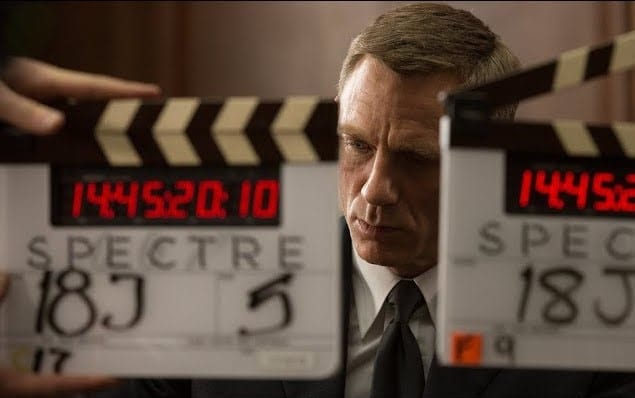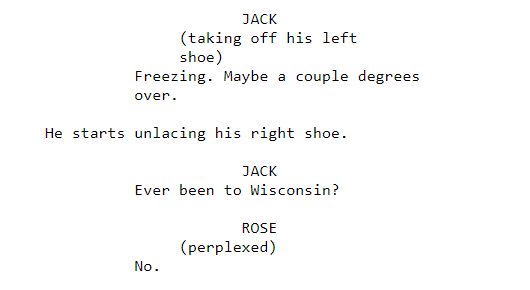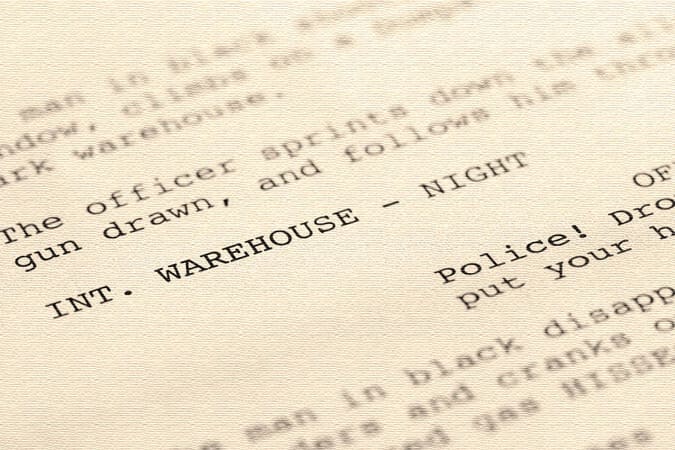Crafting good quality stage directions can often be one of the trickiest parts of writing a screenplay. The directions need to be clear and concise but also need to engage the reader. With a number of do’s and don’ts, we’re providing the lowdown on writing stage directions in a screenplay.
Table of Contents
Stage Directions: An Intro
So what are stage directions? Well, these are the parts of your screenplay that will help describe the action around the dialogue.
The etymology is of course from the theater, where ‘stage directions’ would be what is written in the playtext to provide information relevant to the staging of the play.
Broadly speaking, it would tell actors where to go, set designers what to design and directors what to focus on. Stage directions can be literal and functional in describing what is happening, or they can be more abstract and poetic in setting the scene. This is exemplified by probably the most famous stage direction of all time, Shakespeare’s ‘Exit pursued by a bear’ from The Winter’s Tale.
So whilst stage directions can be replaced by screen directions within a screenplay, the same basic rule applies.
The three key things your stage directions should focus on:
- Describing the action happening in the scene
- The location of the scene
- Describing the characters
It’s worth noting that when it comes to stage directions, the rules can be flexible. Ultimately, if your script is clear in conveying the story and readable in doing so, then rules and traditions can be played with.
However, a solid set of guidelines is always useful to follow in making your script as effective as possible and making sure that beleaguered script readers are helped rather than hindered in comprehending your story.

How To: Format
When it comes to starting to write your stage directions, first of all, you need to keep the format in mind.
Stage directions aren’t supposed to be written like a long, embellished story. You need to write clearly and directly, avoiding big chunks of text and long-winded sentences.
If a screenplay reader is presented with large blocks of text there’s a risk of them getting bored or distracted. You want them to be caught up in the excitement of your story, not trawling through unnecessary descriptions of what the weather is like that particular day.
Utilize short, punchy sentences that are easy to read, with preferably no more than two or three-line paragraphs. That way, the reader will get a feel of how the events will unfold when they’re actually on screen.
The present tense should be used when writing stage directions. The action should be happening now, not in the past.
- Steer clear of using phrases like, ‘We see the man dealing a deck of cards.’
- Instead, phrase it like this, ‘The man deals a deck of cards.’
Another formatting detail to employ in your stage directions is to capitalize an un-introduced character’s name, followed by their age. This capitalization only occurs the first time the character is mentioned in the screenplay. Then after this, their name can be written in lowercase.
Age, meanwhile, is not only obviously important for understanding a character but also for the casting process. With an ensemble cast, this is particularly key as we need to get a clear grasp of how the characters are either similar to or distinguished from one another.

Language and Style used in Stage Directions
The language you need to use when writing stage directions can be one of the hardest things to get used to. Forget everything you were taught in school about metaphors, similes and descriptive writing.
The literary devices that are normally considered to be beneficial for setting the scene in writing, are largely unnecessary here. Elaborate and intricate descriptions with reams of adjectives have little place in stage directions. You need to provide the bare bones and maintain the engagement.
Take the following stage directions…
‘She quickly walked into the very small, dingy, dark room. Thick blood has stained all of the walls, slowing dripping to the floor. The furniture is upturned and ripped apart, stuffing spilling grossly from a nearby armchair.’
Yes, this is an engaging read and would be at home within a piece of prose. It’s well written and illuminative. But try and find a balance between illumination and efficiency.
Instead, you could aim for something more succinct, like this… ‘She strode into the mangled, upturned room, reeling at the blood-stained walls.’
By making the directions too literary, it can slow the pace of the story. The audience will be able to see the room without needing a complete breakdown of every detail. Therefore, use short energetic sentences and leave setting the scene to the production designer and set dressers. Immerse the character, and the reader, into the scene rather than leaving the description feeling too objective.
The description you include should not be intended to give exhaustive detail about exactly how the setting looks but instead used to highlight aspects of the story in terms of the themes, tone and plot. Really interrogate whether your flowing literary description is actually helping convey the story, or if it’s just making sure every corner of a room is shown.
Writing Evocative Stage Directions
On the other hand, you don’t want your script to come across as under-written. The reader still needs to be able to visualise the characters, action, and scenery. So be sure to avoid using generic language. Your thesaurus will be your best friend!
Instead of saying your character ‘walked’, consider making them saunter, stride, trudge or wander. The extra detail will allow the reader to get a better grasp of your character and how they behave, making them more three-dimensional.
Think also about how the description can illuminate something about the character. For example, how can how a character ‘walks’ convey something about their personality? A ‘stride’ could convey confidence. Or a ‘wander’ could convey an easy-going nature.
With such little space and time to introduce characters (particularly supporting characters within large casts) every small piece of detail can make a massive difference.
Similarly, a small piece of incisive description about a setting can transport the reader to that location.
- How does the location inform the mood and feel of the scene?
- What can the setting say about the themes of the story?
These are questions to consider. A gloomy, moody setting can imbue tension in a scene. Or a sun-soaked, hazy setting can imbue joy. Your setting’s description can play a key part in the building of a scene and of the script overall.

Writing About Characters in Stage Directions
The first time you introduce your protagonist or another supporting character, (remember to introduce in caps) it can be tempting to fill half a page with a detailed description of what you imagine them to look like. Rather than overloading the reader with all this unnecessary detail, you need to give more of an overall impression of your character.

Phrases like, ‘A feisty redhead’, or ‘Handsome and well-tailored’ instantly conjure up a clear image in the reader’s mind, without having to describe the character down to every last freckle.
The best character descriptions are incredibly perceptive in that they can sum up a character (or at least how they come across) in just a sentence. Being able to succinctly boil your character down to a pithy, efficient sentence is a true test of how well you know your characters.

Stage Directions in a Spec Script vs a Shooting Script
One of the key things to remember when you begin to write your screenplay is that in this instance, you’re a writer, not a director. By submitting a screenplay that you’ve written in the style of a shooting script; you’ll have wasted valuable time.
If your stage directions include every desired camera angle and every last close-up shot that you imagined, you’ll most likely end up irritating the production team. As a result of this, they’ll probably discard your added directions anyway.
Deciding how the screenplay will be shot is not your job. When writing stage directions, your job is to give a simple explanation of what appears on screen during that particular scene, including action, scenery and what the characters are doing. This is referred to as a spec script. Fingers crossed, when your screenplay is produced, it will be someone else’s job to add in camera angles and shot types.

Avoiding Exposition
Film is obviously, a visual medium, meaning that the audience will only be able to perceive what is physically in front of them. Your stage directions should only contain facts and information that can be physically filmed and recorded.
When writing your screenplay, it is important to keep the idea of, ‘show, don’t tell’, in mind. Overly expositional writing can feel clunky and amateur.
Take the following stage direction…
‘Her mouth dropped open, visibly shocked at what she saw. The smell was also horrendous.’
You don’t have to tell the reader she is visibly shocked; you can infer it by her reaction. It’s important that you don’t try and tell the audience what they can’t see. You can’t tell them that the smell was horrendous if they can’t physically see it.
Instead, add in a short description of the character wrinkling their nose in disgust. You have to show that the room smelt horrendous through the character. If the stage direction provides information about the character that can be visually represented (even if somewhat ambiguous), then it is valid.
How To: Transitions
When writing your screenplay, an important detail to pay attention to is the transitions that you use. Be sure to familiarise yourself with the industry-standard screenplay format before starting to add these elements.
Here’s a short guide to the most commonly used transitions and what their purpose is.
- CUT TO: – This is the simplest, as well as most common, transition. This implies a change of scene over the course of one frame.
- DISSOLVE TO: – This transition indicates one scene fading out, as the next scene fades into place instantly after. It represents a passage of time, or simply used for dramatic effect.
- FADE IN: / FADE OUT: – These transitions are used at the beginning of the screenplay (FADE IN:) and at the end of the screenplay (FADE OUT:) to simply indicate the start and end of the story.
- FREEZE FRAME: – This one is fairly self-explanatory. Whatever scene is on the screen will momentarily pause, as if it were a photo.
- FLASH CUT TO: – A flash cut shows an extremely brief shot, designed to flash in front of the audience’s eyes.
- SMASH CUT TO: – A smash cut is completely unexpected. Horror films use it, cutting from an intense, scary scene, to a completely unrelated, calm scene. It should feel abrupt and unexpected.
- JUMP CUT TO: – This transition makes the subject appear to jump forward in time by breaking a single shot with a well-timed cut.
How To: Parentheses
An important part of formatting your screenplay is parentheses. They come hand in hand with the stage directions. Adjectives are put in parentheses, just below the characters name, to describe how the character speaks a line. Or it could be a verb that gives the actor an action to complete whilst speaking the line.
However, it’s important that you use them sparingly and only when absolutely necessary. It is the job of the actor to add emotion, tone and gestures to the performance. Use a parenthesis only when absolutely necessary, in a situation where the intention might be hard to read from the dialogue. Every line of dialogue within a scene with a parenthesis under it would look very jarring indeed.
Parentheses are used in this example from Titanic to follow the action of Jack taking off his shoe, whilst still speaking, as well as capturing Rose’s emotions.

It might be easy to miss that Rose is ‘perplexed’ by Jack’s question. A simple ‘No’ could be read in a number of different ways, all missing the point of her reaction to the question. By using a parenthesis, the intention becomes clear. Furthermore, there’s a dynamism to having Jack take off his shoe as he talks. The action continues through the dialogue, creating a feeling of movement.
In Summary
Stage directions are the parts of your script around your dialogue that help describe the action, setting and characters.
‘The man deals a deck of cards’ or ‘Katy enters the room’ are examples of stage directions. They describe the movements of the characters in the scene. Furthermore, setting description such as ‘the morning sunlight fills the room’ is also an example of stage direction.
You need to find a balance between efficiency and fluency in your stage directions. They need to paint a picture of the scene but in a way that doesn’t stop the flow and pace of the script. Try to always be immersive, plunging your characters and consequently the reader into the action, rather than writing from an objective point of view.
What did you think of this article? Share It, Like It, give it a rating, and let us know your thoughts in the comments box further down…
– Struggling with a script or book? Story analysis is what we do, all day, every day… check out our range of script coverage services for writers & filmmakers.
This article was written by Isabelle Collingridge and edited by IS Staff.
Get *ALL* our FREE Resources
Tackle the trickiest areas of screenwriting with our exclusive eBooks. Get all our FREE resources when you join 60,000 filmmakers on our mailing list!


Ryan
( setting down his book bag from his left shoulder and putting it on the counter)
Today was a long day.
Starts to unzip jacket.